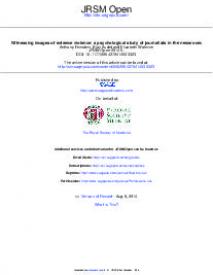Witnessing images of extreme violence: a psychological study of journalists in the newsroom
Objective User Generated Content – photos and videos submitted to newsrooms by the public – has become a prominent source of information for news organisations. Journalists working with uncensored material can frequently witness disturbing images for prolonged periods. How this might affect their psychological health is not known and it is the focus of this study. Design Descriptive, exploratory. Setting The newsrooms of three international news organisations. Participants One hundred and sixteen journalists working with User Generated Content material. Main outcome measures Psychometric data included the re-experiencing, avoidance and autonomic arousal indices of posttraumatic stress disorder (Impact of Event Scale-revised), depression (Beck Depression Inventory-II; BDI-II), a measure of psychological distress (GHQ-28), the latter comprising four subscales measuring somatisation, anxiety, social dysfunction and depression, and mean weekly alcohol consumption divided according to gender. Results Regression analyses revealed that frequent (i.e. daily) exposure to violent images independently predicted higher scores on all indices of the Impact of Event Scale-revised, the BDI-II and the somatic and anxiety subscales of the GHQ-28. Exposure per shift only predicted scores on the intrusion subscale of the Impact of Event Scale-revised. Conclusions The present study, the first of its kind, suggests that frequency rather than duration of exposure to images of graphic violence is more emotionally distressing to journalists working with User Generated Content material. Given that good journalism depends on healthy journalists, news organisations will need to look anew at what can be done to offset the risks inherent in viewing User Generated Content material. Our findings, in need of replication, suggest that reducing the frequency of exposure may be one way to go.
Geachte bezoeker,
De informatie die u nu opvraagt, kan door psychotraumanet niet aan u worden getoond. Dit kan verschillende redenen hebben,
waarvan (bescherming van het) auteursrecht de meeste voorkomende is. Wanneer het mogelijk is om u door te verwijzen naar de bron
van deze informatie, dan ziet u hier onder een link naar die plek.
Als er geen link staat, kunt u contact opnemen met de bibliotheek,
die u verder op weg kan helpen.
Met vriendelijke groet,
Het psychotraumanet-team.
Reference:
Anthony Feinstein, Blair Audet, Elizabeth Waknine | 2014
In: Journal of the Royal Society of Medicine Open, ISSN 2054-2704 | 5 | 8 | augustus | 1-7
http://shr.sagepub.com/content/5/8/2054270414533323
In: Journal of the Royal Society of Medicine Open, ISSN 2054-2704 | 5 | 8 | augustus | 1-7
http://shr.sagepub.com/content/5/8/2054270414533323


